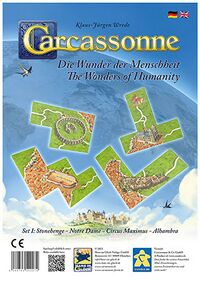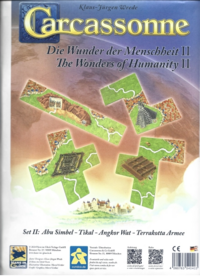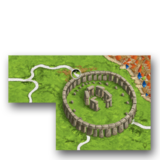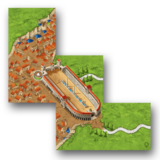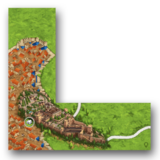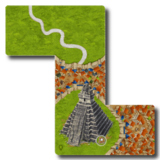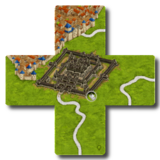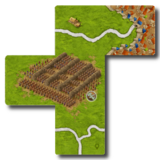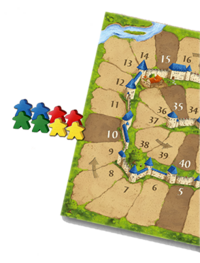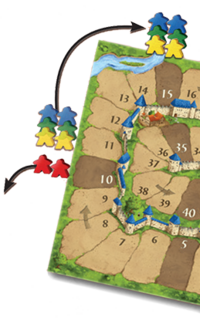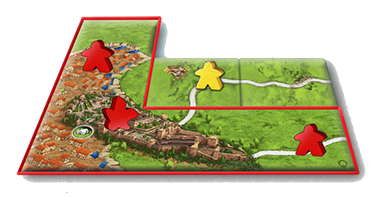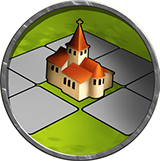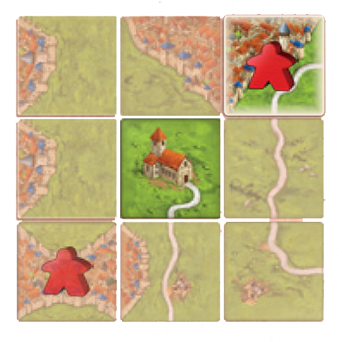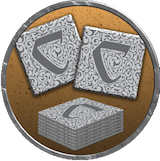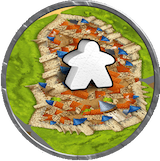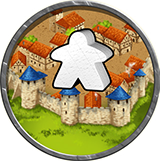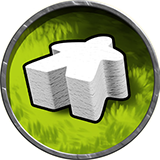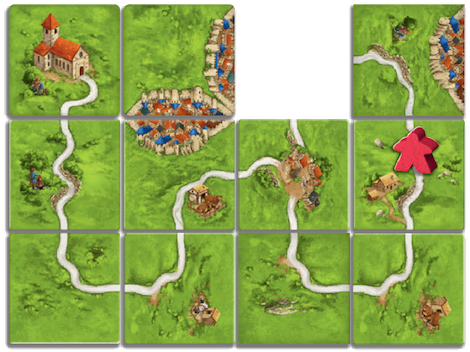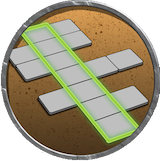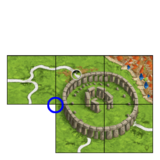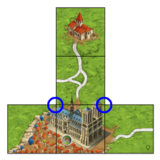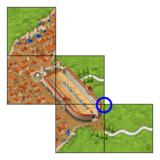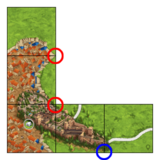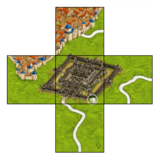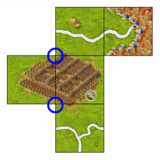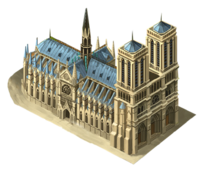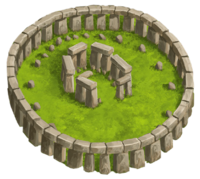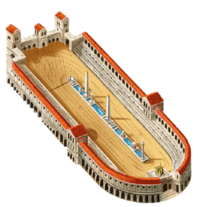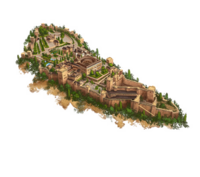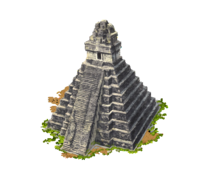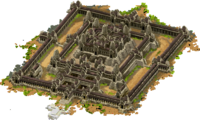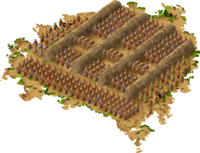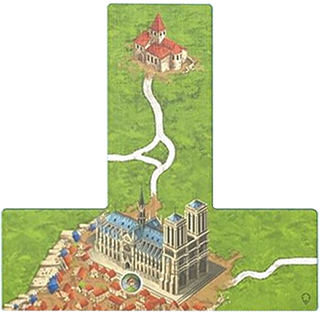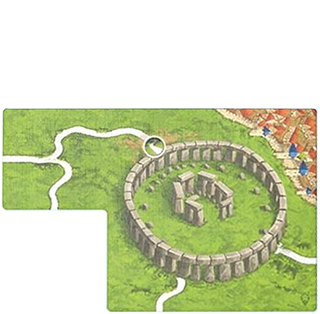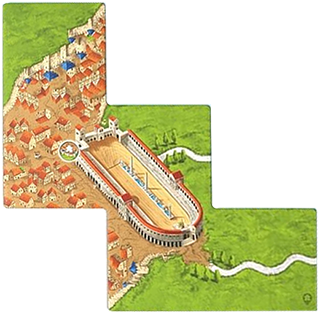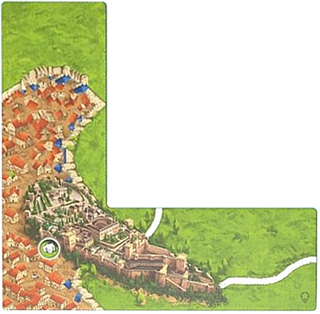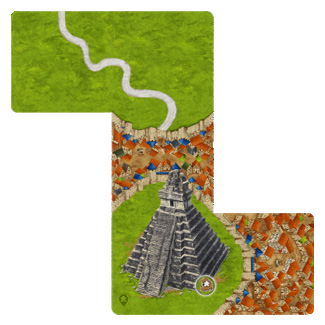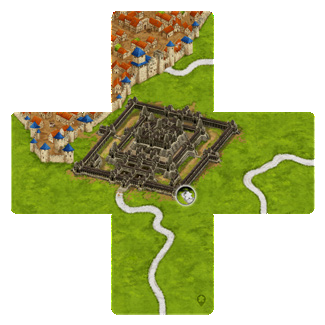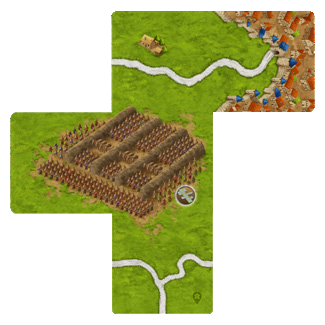The Wonders of Humanity
 |
You are reading the rules for this tile design. |
| This expansion was not published in other editions. |
| If your tiles have a different design, then choose a game from Spin-offs. |  |

The Wonders of Humanity expansion contains mega tiles spanning across 5 spaces in various configurations. Each mega tile feature a wonder built by man in different ages. Each of them brings you individual advantages. But everyone can only use one per game. Get a matching wonder quickly to benefit from it as often as possible!
The wonders of humanity have reached Carcassonne. Each of them brings you individual advantages. But everyone can only use one per game. Get the wonder you want quickly to benefit from it as often as possible!
General info and comments
The Wonders of Humanity was released by Hans im Glück in 2023 (Set I) and 2024 (Set II). The expansion contains wonder tiles spanning across 5 spaces in various configurations. Each tile features a wonder built by man in different ages. The first set contains the following wonders:
- Stonehenge, a prehistoric monument located near Amesbury in southern England (UK).
- Circus Maximus, an ancient Roman chariot-racing stadium and mass entertainment venue in Rome, Italy.
- Notre-Dame, a medieval Gothic cathedral built in Paris, France.
- Alhambra, a palace and fortress complex from the 13th century located in Granada, Spain.
The second set contains the following wonders:
- Abu Simbel, a pair of rock temples built in Egypt in the 13th century BC.
- Tikal, an ancient Mayan city in northern Guatemala.
- Angkor Wat, a 10th century temple complex in Cambodia.
- Terracotta Army, more than 7000 life-size soldiers in an early Chinese burial complex.
This expansion has cities with clipped buildings.
Note: All wonders tiles count as 5 connected normal tiles.
Contents
Set I
- 4 wonder tiles with Wonders of Humanity
Note: The map printed on the back of the first set of wonder tiles (Stonehenge, Notre-Dame, Circus Maximus and Alhambra) is only relevant for the Carcassonne Game Festival 2023 in Carcassonne.
Set II
- 4 wonder tiles with Wonders of Humanity
Rules
Preparation
We recommend you to play with at least 90 tiles and one additional meeple (e.g. Base game + 1st expansion). [1] Ignore any additional expansion rules.
- Each player takes all 9 meeples in one color. Place 2 meeples in each color next to the 10 space outside the scoreboard.
- Note: One of these two meeples is used only to mark your wonder. You can use the large meeple of the 1st expansion or any other figure in that color.
- Place a scoring meeple as usual on the 0 space of the scoreboard. All players start the game with 6 meeples in their supply.
- Choose 1 wonder tile per player. You can also combine wonders from different sets. Place them face-up next to the scoreboard. Discard the remaining wonder tiles, you do not need them for this game. [2]
Note: Alternatively, you can also prepare as many wonders as you like. You'll have a bigger selection of wonders and you can choose the right wonder for you, later in the game.
Placing a wonder tile
There is one wonder for each player. To receive a wonder tile, you must fulfill a condition. This falls under section 3. Scoring a feature described next:
3. Scoring a feature and getting a wonder tile
There is 1 wonder for each player. So you can get a wonder tile only once during the game. (For a variant with two wonders per player, see below.)
When your scoring meeple reaches or exceeds the space with the meeple pairs (the first time it is the 10 space), you perform the following steps in sequence:
- Choose one of the wonder tiles available and place it in front of you. You don't place it on the game board yet (see 1. Placing a wonder tile).
- Take your two meeples next to the scoreboard and add them to your supply.
- Move all remaining meeples placed next to the scoreboard 5 spaces forward (i.e. the first time next to the 15 space, then next to the 20 space, and finally next to the 25 space).
Attention: You must never move the meeple pairs beyond the 25 space, even if there are more than 4 players. The meeples remain next to the 25 space until they are reached by all other scoring meeples.
Special case:
If several players reach the space with the meeple pairs on the same turn, the person whose turn it is chooses which of them will take a wonder tile. After that, the meeple pairs are moved 5 spaces forward as usual. If there are still scoring meeples from other players (who have not taken a wonder yet) on or past the space with the meeple pairs, the person whose turn it is decides again who will take the next wonder, and so on.
1. Placing a wonder tile
If there is a wonder tile in front of you, you do not draw a tile, but instead place your wonder tile according to the usual placement rules. [3] Once you have placed it, you have to mark your wonder with one of the 2 meeples that you obtained along with the wonder tile. To do so, place the marker meeple in the center of the wonder (not on a city, road or field). This marker meeple remains there until the end of the game. For a better distinction from other meeples, you can put the marker meeple upside down.
Note: In the very rare case that there is no way to place the wonder tile correctly, you draw a tile that you must immediately place so that you can immediately place your wonder tile next to it afterwards. If this is also not possible, the normal tile is removed from the game (even if it would have fit) and you draw another tile, until you can place your wonder tile. You do not place a meeple on the additionally drawn tile.
Special case: The game ends when nobody can place a land tile or a wonder tile during their turn, even if other players still have wonder tiles. [4]
2. Placing a meeple on a wonder tile
After you have placed and marked your wonder, you may immediately place up to 2 meeples on different unoccupied features (city, road, monastery or field) of this wonder tile. You may also place only one or no meeples. If you place 2 meeples, they may also be placed on the same square. [5]
3. Scoring a wonder
Each wonder has its own function that can earn you points. Some wonders give you points during the game, while others give you points at the end of the game. [6]
During the game (not during the turn in which you place the Notre-Dame wonder tile), if you place a meeple on one of the 8 tiles surrounding a monastery, you immediately score 3 points. It is irrelevant whether there is a monk on this monastery or not. [7] Even if several monasteries are adjacent to the tile where the meeple is placed, you will "only" receive 3 points. [8]
If you complete one or more occupied roads during your turn (not when playing the Stonehenge wonder tile itself), you immediately score 3 points for each road you complete (even if you don't have a meeple on the road yourself). After that, you score the road as usual. [9]
![]() Question: Do you get the Stonehenge bonus if you complete an unoccupied road and then you add a meeple to it on the tile just placed?
Question: Do you get the Stonehenge bonus if you complete an unoccupied road and then you add a meeple to it on the tile just placed?
Answer: Yes it is possible. You place the meeple in 2. Placing a meeple right before you perform 3. Scoring with a wonder. (3/2024)
When it's your turn, you can choose from 2 tiles. The first time you draw 2 tiles. You choose one and place it as usual. Place the other one face down in front of you for a later turn. When it's your turn again, you draw another tile and choose from 2 tiles again, and so on. If there are no more tiles for you to draw at the end of the game, place the one in front of you. If your unchosen tile is the last one in the game, it goes to the next player for the last turn.
If a city is scored that is at least 3 tiles in size and in which you have at least one meeple, you receive 2 points for each of your own meeples in a city on the board. The following applies:
- You do not have to have the majority in the scored city.
- The meeple in the scored city also scores 2 points.
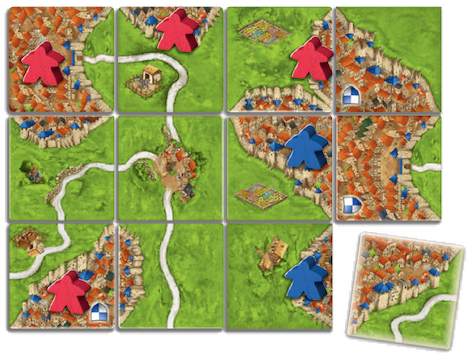
At the end of the game, depending on the number of players, you will receive points for each meeple of another color in still uncompleted cities:
| 2 players: | 4 points | |
| 3-4 players: | 3 points | |
| 5+ players: | 2 points |
For each road (incomplete or complete) that is at least 5 tiles long, you receive 5 points at the end of the game.
You receive 2 points for every 7+ tiles that are in a row or column on the board at the end of the game. The following applies:
- You may score identical tiles for the column and for the row.
- Each column and row is only scored once.
Important!
- Each wonder tile counts as 5 individual normal tiles. Accordingly, the roads and cities can consist of more than one tile. You must take this into account during the scoring.
- Set I:
- Stonehenge and Notre-Dame each have a road that spans across 2 tiles.
- The Alhambra has a city that spans across 3 tiles, the Circus Maximus has a city that spans across 4 tiles, and Notre-Dame has a city that spans across 2 tiles. [12]
- Set II:
- Abu Simbel, Angkor Wat, and Terracotta Army each have a road that extends over 2 tiles. Tikal has a road that extends over 3 tiles.
- Tikal and Angkor Wat each have unconnected city segments. [13]
- Set I:
Final Scoring
At the end of the game, you first score the wonders that score at the end of the game. After that, you continue with the normal final scoring. [14]
 Variant - 2 wonders per player
Variant - 2 wonders per player
If you are already familiar with this expansion, you can also try out the following variant, in which each player receives up to 2 wonders in the game. You now receive the effects of both wonders. Depending on the situation, you can also build interesting combinations.
Note: All the rules of the game remain the same. We are only listing changes here.
Setup
We recommend that you play with at least 120 or more tiles and 2 additional meeples (e.g. base game + river + 1st expansion and any other tiles from (mini) expansions). But ignore the expansion rules.[15]
- Each player takes 10 meeples of one color. Place 2 meeples of each color next to space 10 outside the scoring board, and 1 meeple next to the 0/50 starting space.
- Choose 2 or any number of wonders per player and place them next to the scoring board.
Receive the second wonder tile
If your counting meeple reaches or exceeds the 50 space, you choose your second wonder, place it in front of you and take the meeple next to the 0/50 starting space. After that, you use it to mark your second wonder on your next turn, after you have placed it.
Additional clarifications
Roads, cities and fields on wonder tiles
![]() Some wonder tiles include multiple cities spreading across multiple square spaces. Each space should be counted like a separate tile. The following images illustrate the number of road and city tiles to consider for each wonder tile as well as the intended field connectivity. Blue circles represent connected fields and red circles represent separated fields.
Some wonder tiles include multiple cities spreading across multiple square spaces. Each space should be counted like a separate tile. The following images illustrate the number of road and city tiles to consider for each wonder tile as well as the intended field connectivity. Blue circles represent connected fields and red circles represent separated fields.
Notes:
- The dirt patches next to some wonders are part of the wonder, not part of the adjacent city.
- The die-cutting of the wonder tiles may affect field connectivity due to production variations. If playing with wonder tiles diverging from the intended field connectivity, players will have to agree on the field connectivity to apply.
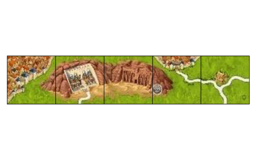 |
Abu Simbel
|
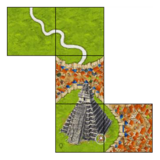 |
Tikal
|
![]() Question: Does the city on the Notre-Dame wonder tile span 2 or 4 tiles? The dirt patches surrounding Notre-Dame extend to 2 adjacent square spaces (top and right). It is a bit ambiguous in visual terms, since there is no actual wall closing the city but the houseless dirt patches with Notre-Dame bordering the field.
Question: Does the city on the Notre-Dame wonder tile span 2 or 4 tiles? The dirt patches surrounding Notre-Dame extend to 2 adjacent square spaces (top and right). It is a bit ambiguous in visual terms, since there is no actual wall closing the city but the houseless dirt patches with Notre-Dame bordering the field.
Answer: The city only spans across 2 tiles. The dirt patches surrounding Notre-Dame are graphically necessary to close off the roads there. (3/2024)
![]() Question: The outer stone circle limits the surrounding fields, so there are 4 fields on the Stonehenge wonder tile. Is this correct?
Question: The outer stone circle limits the surrounding fields, so there are 4 fields on the Stonehenge wonder tile. Is this correct?
Answer: It is exactly right. (3/2024)
![]() A farmer placed in a field only bordering a wonder but not the city adjacent to the wonder will not score points for this city. This may happen to some fields on wonder tiles:
A farmer placed in a field only bordering a wonder but not the city adjacent to the wonder will not score points for this city. This may happen to some fields on wonder tiles:
- The field surrounding the monastery on the Notre-Dame wonder tile (top right)
- The field between the roads on the Circus Maximus wonder tile (center right)
- The field between the roads on the Alhambra wonder tile (center right)
Note that wonders (including the dirt patches next to them) are separate features from cities. Wonders limit cities but are not part of them.
![]() Question: Some wonders such as Notre-Dame, Circus Maximus and Alhambra include a field between two roads that touches the wonder. Is this field considered to touch the city or only the wonder (and therefore no city)?
Question: Some wonders such as Notre-Dame, Circus Maximus and Alhambra include a field between two roads that touches the wonder. Is this field considered to touch the city or only the wonder (and therefore no city)?
Answer: The field only touches the wonder. A wonder is always neutral and not part of a city. (3/2024)
Monasteries and wonder tiles
![]() Each square space on a wonder tile counts as a separate tile when scoring monasteries. This applies to monasteries adjacent to wonder tiles and to monasteries on a wonder tile.
Each square space on a wonder tile counts as a separate tile when scoring monasteries. This applies to monasteries adjacent to wonder tiles and to monasteries on a wonder tile.
Other expansions
This section contains additional information about the interactions with other Carcassonne expansions.
![]() You may place 0, 1 or 2 wooden meeples on a wonder tile. This is one single action.
You may place 0, 1 or 2 wooden meeples on a wonder tile. This is one single action.
- If you only place one wooden meeple, you cannot perform any other action instead of placing the second wooden meeple. [16]
- If you only place one or two wooden meeples, you may use direct placement and even another placement mechanic available for one of the meeples: "Add Meeple" / "Place Meeple" (
 20th Anniversary Expansion).
20th Anniversary Expansion).
![]() The wooden meeples that can be placed on the wonder tile are the following:
The wooden meeples that can be placed on the wonder tile are the following:
- Normal meeple (
 Base Game)
Base Game) - Abbot (Base Game -
 The Abbot)
The Abbot) - Large meeple (
 Exp. 1 - Inns & Cathedrals)
Exp. 1 - Inns & Cathedrals) - Wagon (
 Exp. 5 - Abbey & Mayor)
Exp. 5 - Abbey & Mayor) - Mayor (
 Exp. 5 - Abbey & Mayor)
Exp. 5 - Abbey & Mayor) - Ringmaster (
 Exp. 10 - Under the Big Top)
Exp. 10 - Under the Big Top) - Guard meeple (
 Exp. 11 - Ghosts, Castles & Cemeteries)
Exp. 11 - Ghosts, Castles & Cemeteries)
![]() After placing 0, 1 or 2 wooden meeples on the wonder tile, you may place:
After placing 0, 1 or 2 wooden meeples on the wonder tile, you may place:
![]() All monastic buildings can trigger the Notre-Dame bonus when placing a meeple on an adjacent tile:
All monastic buildings can trigger the Notre-Dame bonus when placing a meeple on an adjacent tile:
- Monastery (
 Base Game)
Base Game) - Abbey (
 Exp. 5 - Abbey & Mayor)
Exp. 5 - Abbey & Mayor) - Shrine (
 Exp. 6 - Count, King & Robber)
Exp. 6 - Count, King & Robber) - German monastery (
 Monasteries in Germany)
Monasteries in Germany) - Dutch & Belgian monastery (
 Monasteries in the Netherlands & Belgium)
Monasteries in the Netherlands & Belgium) - Japanese Building (
 Japanese Buildings)
Japanese Buildings) - Darmstadt Church (
 Darmstadt Promo)
Darmstadt Promo)
![]() The following features do not trigger the Notre-Dame bonus when placing a meeple on an adjacent tile:
The following features do not trigger the Notre-Dame bonus when placing a meeple on an adjacent tile:
- Garden (Base Game -
 The Abbot)
The Abbot) - German Cathedral (
 German Cathedrals)
German Cathedrals)
![]() If you place a wooden meeple on the wonder tile, you cannot remove your abbot instead of placing a second wooden meeple.
If you place a wooden meeple on the wonder tile, you cannot remove your abbot instead of placing a second wooden meeple.
![]() A garden does not trigger the Notre-Dame bonus when placing a meeple on an adjacent tile.
A garden does not trigger the Notre-Dame bonus when placing a meeple on an adjacent tile.
![]() If you place a wooden meeple on the wonder tile, you cannot place your builder or your pig instead of a second wooden meeple.
If you place a wooden meeple on the wonder tile, you cannot place your builder or your pig instead of a second wooden meeple.
![]() Exp. 3 - The Princess & the Dragon
Exp. 3 - The Princess & the Dragon
![]() If you place a wooden meeple on the wonder tile, you may not move the fairy instead of placing a second wooden meeple.
If you place a wooden meeple on the wonder tile, you may not move the fairy instead of placing a second wooden meeple.
![]() If you add the fairy to a meeple on the wonder tile, the whole wonder tile is protected from the dragon. The dragon cannot land on any square space of the wonder tile.
If you add the fairy to a meeple on the wonder tile, the whole wonder tile is protected from the dragon. The dragon cannot land on any square space of the wonder tile.
![]() The fairy cannot be added to the marker meeple on a wonder tile.
The fairy cannot be added to the marker meeple on a wonder tile.
![]() The wonder tile is one single tile but it represents 5 spaces for the movement of the dragon. The dragon affects the whole tile when it lands on it (except for the marker meeple on the wonder itself), but it may represent 5 steps in its movement. The wonder is a special area not affected by the dragon.
The wonder tile is one single tile but it represents 5 spaces for the movement of the dragon. The dragon affects the whole tile when it lands on it (except for the marker meeple on the wonder itself), but it may represent 5 steps in its movement. The wonder is a special area not affected by the dragon.
![]() If you extend the city on a wonder tile with a princess tile, you may remove any meeple on the city. However, you cannot remove the marker meeple.
If you extend the city on a wonder tile with a princess tile, you may remove any meeple on the city. However, you cannot remove the marker meeple.
![]() You may use a magic portal to place a meeple on any uncompleted, unoccupied feature on a wonder tile. You may not use the magic portal to place a meeple on the wonder itself, since it is a special area with special placement rules.
You may use a magic portal to place a meeple on any uncompleted, unoccupied feature on a wonder tile. You may not use the magic portal to place a meeple on the wonder itself, since it is a special area with special placement rules.
![]() Wonder tiles count as one tile for the tower, but they represent 5 spaces for the tower range. If at least one of the spaces occupied by a wonder tile is in range from the tower, any meeple placed on the tile can be captured, except the marker meeple.
Wonder tiles count as one tile for the tower, but they represent 5 spaces for the tower range. If at least one of the spaces occupied by a wonder tile is in range from the tower, any meeple placed on the tile can be captured, except the marker meeple.
![]() A tower cannot capture a marker meeple. The wonder is a special area which cannot be affected by a tower.
A tower cannot capture a marker meeple. The wonder is a special area which cannot be affected by a tower.
![]() If you place a wooden meeple on a wonder tile, you cannot place your barn instead of a second wooden meeple.
If you place a wooden meeple on a wonder tile, you cannot place your barn instead of a second wooden meeple.
![]() The general rule states that the base for the barn has to be stable - that means that the corner of all four tiles have to touch each other and all tiles must have field in the corner for the placement of the barn.
The general rule states that the base for the barn has to be stable - that means that the corner of all four tiles have to touch each other and all tiles must have field in the corner for the placement of the barn.
A wonder tile can therefore occupy one, two or three of the corners under the barn.
![]() When moving the wagon after scoring, consider the unoccupied, uncompleted features on its current tile and any other tile (square or not) overlapping its adjacent square spaces.
When moving the wagon after scoring, consider the unoccupied, uncompleted features on its current tile and any other tile (square or not) overlapping its adjacent square spaces.
- If the wagon is on a wonder tile, any of its features is considered adjacent.
- If the wagon is on a square tile adjacent to a wonder tile, any of the features on the wonder tile is considered adjacent.
- If the wagon is on a wonder tile, any feature on a square or wonder tile on and adjacent square space is considered adjacent.
![]() An abbey can trigger the Notre-Dame bonus when placing a meeple on an adjacent tile.
An abbey can trigger the Notre-Dame bonus when placing a meeple on an adjacent tile.
![]() A shrine can trigger the Notre-Dame bonus when placing a meeple on an adjacent tile.
A shrine can trigger the Notre-Dame bonus when placing a meeple on an adjacent tile.
![]() The Knock Out token and the Seduction token do not affect the marker meeple on a wonder tile.
The Knock Out token and the Seduction token do not affect the marker meeple on a wonder tile.
![]() Exp. 8 - Bridges, Castles & Bazaars
Exp. 8 - Bridges, Castles & Bazaars
![]() A bridge can be placed on a wonder tile if the conditions are met for the give square space.
A bridge can be placed on a wonder tile if the conditions are met for the give square space.
![]() If one or more spaces of a wonder tile overlap a castle fief, any feature completed on those spaces (road, city or monastery) will trigger the castle scoring.
If one or more spaces of a wonder tile overlap a castle fief, any feature completed on those spaces (road, city or monastery) will trigger the castle scoring.
- The castle will consider each space on the wonder tile as a separate tile.
- The features on the spaces in the castle vicinity will be the ones that can trigger the castle scoring. [17]
![]() If you place a meeple on a wonder tile, you cannot place your shepherd instead of a second wooden meeple.
If you place a meeple on a wonder tile, you cannot place your shepherd instead of a second wooden meeple.
![]() If you place a wonder tile adjacent to a tile with an acrobat space, you can only add one acrobat to the pyramid instead of placing meeples on the wonder tile.
If you place a wonder tile adjacent to a tile with an acrobat space, you can only add one acrobat to the pyramid instead of placing meeples on the wonder tile.
![]() If you place a wooden meeple on a wonder tile, you cannot score an acrobat pyramid instead of placing a second wooden meeple.
If you place a wooden meeple on a wonder tile, you cannot score an acrobat pyramid instead of placing a second wooden meeple.
![]() A marker meeple does not receive points for the big top.
A marker meeple does not receive points for the big top.
![]() If you place a wooden meeple on a wonder tile, you cannot place a meeple on the crown of the Wheel of Fortune instead of a second wooden meeple.
If you place a wooden meeple on a wonder tile, you cannot place a meeple on the crown of the Wheel of Fortune instead of a second wooden meeple.
![]() The wonder tile counts as 1 tile occupying 5 spaces. The flier considers spaces for its movement. If the flier lands on a space occupied by a wonder tile, it can choose any feature on the whole tile, that is, the flier has the choice of various roads, a city or a monastery, if available. The flier can only land on one of these features if it is not yet finished.
The wonder tile counts as 1 tile occupying 5 spaces. The flier considers spaces for its movement. If the flier lands on a space occupied by a wonder tile, it can choose any feature on the whole tile, that is, the flier has the choice of various roads, a city or a monastery, if available. The flier can only land on one of these features if it is not yet finished.
![]() If the flight of the flier is diagonal, all steps must be in a straight line in the direction the arrow shows from the flying machine tile. The angle cannot change. If the flier lands on a space occupied by a wonder tile then the flier has the choice of various roads, a city or a monastery, if available. The flier can only land on one of these features if it is not yet finished.
If the flight of the flier is diagonal, all steps must be in a straight line in the direction the arrow shows from the flying machine tile. The angle cannot change. If the flier lands on a space occupied by a wonder tile then the flier has the choice of various roads, a city or a monastery, if available. The flier can only land on one of these features if it is not yet finished.
![]() A flying machine cannot add a marker meeple to a wonder.
A flying machine cannot add a marker meeple to a wonder.
![]() You cannot remove a marker meeple with a festival.
You cannot remove a marker meeple with a festival.
![]() Monasteries in Germany /
Monasteries in Germany / ![]() Monasteries in the Netherlands & Belgium /
Monasteries in the Netherlands & Belgium / ![]() Japanese Buildings
Japanese Buildings
![]() A special monastery can trigger the Notre-Dame bonus when placing a meeple on an adjacent tile.
A special monastery can trigger the Notre-Dame bonus when placing a meeple on an adjacent tile.
![]() Wonder tiles will be considered as 5 square spaces when scoring the abbot/claustral prior on a special monastery. Special monasteries will count those square spaces in the columns and rows starting from the monastery tile.
Wonder tiles will be considered as 5 square spaces when scoring the abbot/claustral prior on a special monastery. Special monasteries will count those square spaces in the columns and rows starting from the monastery tile.
- Depending on the position of a wonder tile overlapping any of those rows or columns, one or more spaces of a wonder tile will be taken into consideration for the scoring. [18]
![]() A German cathedral does not trigger the Notre-Dame bonus when placing a meeple on an adjacent tile.
A German cathedral does not trigger the Notre-Dame bonus when placing a meeple on an adjacent tile.
![]() If you activate an "Add Meeple" symbol when placing a wonder tile, you can use the action with one wooden meeple and place the other wooden meeple on the wonder tile as usual.
If you activate an "Add Meeple" symbol when placing a wonder tile, you can use the action with one wooden meeple and place the other wooden meeple on the wonder tile as usual.
![]() If you activate a "Place Meeple" symbol when placing a wonder tile, you can use the action with one wooden meeple and place the other on the wonder tile as usual.
If you activate a "Place Meeple" symbol when placing a wonder tile, you can use the action with one wooden meeple and place the other on the wonder tile as usual.
![]() A marker meeple cannot be added a second meeple.
A marker meeple cannot be added a second meeple.
![]() If you place one or two wooden meeples on a wonder tile, you may protect each of them individually.
If you place one or two wooden meeples on a wonder tile, you may protect each of them individually.
![]() If you place a wooden meeple on a wonder tile, you may not protect a meeple previously placed on the board instead of placing a second wooden meeple.
If you place a wooden meeple on a wonder tile, you may not protect a meeple previously placed on the board instead of placing a second wooden meeple.
![]() A marker meeple cannot be protected from peasant revolts.
A marker meeple cannot be protected from peasant revolts.
![]() If you place a wooden meeple on a wonder tile, you may not place or move your tollhouse token instead of placing a second wooden meeple.
If you place a wooden meeple on a wonder tile, you may not place or move your tollhouse token instead of placing a second wooden meeple.
![]() The Plague - Plague spreading
The Plague - Plague spreading
![]() A wonder tile counts as 1 tile for the plague tokens, but 5 spaces for its movement (similar to the dragon).
A wonder tile counts as 1 tile for the plague tokens, but 5 spaces for its movement (similar to the dragon).
![]() If you place a wooden meeple on a wonder tile, you may not place a little building token instead of placing a second wooden meeple.
If you place a wooden meeple on a wonder tile, you may not place a little building token instead of placing a second wooden meeple.
![]() A Darmstadt church can trigger the Notre-Dame bonus when placing a meeple on an adjacent tile.
A Darmstadt church can trigger the Notre-Dame bonus when placing a meeple on an adjacent tile.
![]() If you place a wooden meeple on a wonder tile, you may not remove a meeple trapped by Solovei Razboynik or Vodyanoy instead of placing a second wooden meeple.
If you place a wooden meeple on a wonder tile, you may not remove a meeple trapped by Solovei Razboynik or Vodyanoy instead of placing a second wooden meeple.
![]() Vodyanoy cannot capture a maker meeple on a wonder tile.
Vodyanoy cannot capture a maker meeple on a wonder tile.
The wonders in detail
Rules history
- * 09/2024 Rules for Set II updated the Alhambra bonus from 4 points per farmer to 5 points per farmer, and to 6 points per farmer when playing with at least 120 tiles.
Tile distribution
Set 1
Set 2
Footnotes
For Icons explanation and licensing please visit Icons page.
- ↑
 The initial version of the rules suggested playing with more than just the basic game tiles (about 90+) by adding any tiles you wanted (more basic game tiles or from the (mini) expansions, without applying their rules).
The initial version of the rules suggested playing with more than just the basic game tiles (about 90+) by adding any tiles you wanted (more basic game tiles or from the (mini) expansions, without applying their rules).
- ↑
 One set of wonders only allows you to play with up to 4 players. You will need two sets to play with more than 4 players.
One set of wonders only allows you to play with up to 4 players. You will need two sets to play with more than 4 players.
- ↑
 A wonder tile can be placed adjacent to another wonder tile. There is no limitation affecting their placement beyond the usual rules.
A wonder tile can be placed adjacent to another wonder tile. There is no limitation affecting their placement beyond the usual rules.
 Question: Can a wonder tile be placed adjacent to another wonder tile (edge-to-edge or corner-to-corner)?
Question: Can a wonder tile be placed adjacent to another wonder tile (edge-to-edge or corner-to-corner)?
Answer: Yes, it's possible. (10/2023)
- ↑
 This paragraph was not included in the original rules. However, it has been added for the sake of clarity, since it was clarified in 10/2024 that this ruling applicable to
This paragraph was not included in the original rules. However, it has been added for the sake of clarity, since it was clarified in 10/2024 that this ruling applicable to  Castles in Germany in C3 (3rd Edition) is also valid for this expansion.
Castles in Germany in C3 (3rd Edition) is also valid for this expansion.
- ↑
 This means you may occupy any two different features on the wonder tile even if they are in the same square.
This means you may occupy any two different features on the wonder tile even if they are in the same square.
- ↑
 This sentence was removed from the first revised rules, so the effect of the wonders start on your next turn after placing it:
This sentence was removed from the first revised rules, so the effect of the wonders start on your next turn after placing it:
- Starting with the turn in which you place and mark your wonder, you can use it to score points.
- ↑
 This sentence missing in the original English rules was finally added in the third revised rules released in 10/2023.
This sentence missing in the original English rules was finally added in the third revised rules released in 10/2023.
- ↑
 This sentence was updated in the second revised rules released in 10/2023.
This sentence was updated in the second revised rules released in 10/2023.
- ↑
 This paragraph was updated in the first revised rules released in 10/2023.
This paragraph was updated in the first revised rules released in 10/2023.
- ↑
 This paragraph was updated in 09/2024 with the release of Set 2. Prior to that, farmers scored only 4 points no matter the case.
This paragraph was updated in 09/2024 with the release of Set 2. Prior to that, farmers scored only 4 points no matter the case.
- ↑
 We updated this paragraph to match the German rules, since the wording in the English rules was rather confusing.
We updated this paragraph to match the German rules, since the wording in the English rules was rather confusing.
- ↑
 This sentence was updated according to the clarifications provided in 03/2024 for the sake of completeness and clarity.
This sentence was updated according to the clarifications provided in 03/2024 for the sake of completeness and clarity.
- ↑
 This sentence was added for the sake of completeness and clarity.
This sentence was added for the sake of completeness and clarity.
- ↑
 This sentence was moved to a separate section for the sake of completeness and clarity.
This sentence was moved to a separate section for the sake of completeness and clarity.
- ↑
 Or don't ignore the expansion rules and refer to the Other expansions section of this page for further clarifications from the community. We know what you want.
Or don't ignore the expansion rules and refer to the Other expansions section of this page for further clarifications from the community. We know what you want.
- ↑
 The placement of 1 or 2 wooden meeples as one single action would exclude the possibility of performing any other action in Step 2B-1 (see Order of Play).
The placement of 1 or 2 wooden meeples as one single action would exclude the possibility of performing any other action in Step 2B-1 (see Order of Play).
- ↑ 17.0 17.1
 This is a consequence of a similar official clarification for (haunted) castles and the mist banks on the 2x2 starting tile in
This is a consequence of a similar official clarification for (haunted) castles and the mist banks on the 2x2 starting tile in  Exp. 11 - Ghosts, Castles & Cemeteries.
Exp. 11 - Ghosts, Castles & Cemeteries.
- ↑
 This approach is based on the clarifications provided for The Markets of Leipzig (see FAQ boxes here).
This approach is based on the clarifications provided for The Markets of Leipzig (see FAQ boxes here).
- ↑
 This is a consequence of a similar official clarification for German castles.
This is a consequence of a similar official clarification for German castles.
 Question: If a watchtower scoring for meeples is adjacent to only one half of a double-sized tile, does the watchtower consider those meeples on the half adjacent to the watchtower or all the meeples on the tile?
Question: If a watchtower scoring for meeples is adjacent to only one half of a double-sized tile, does the watchtower consider those meeples on the half adjacent to the watchtower or all the meeples on the tile?
Answer: The watchtower will consider all the meeples on the double-sized tile. (10/2022)
